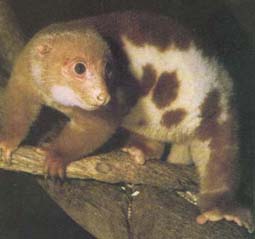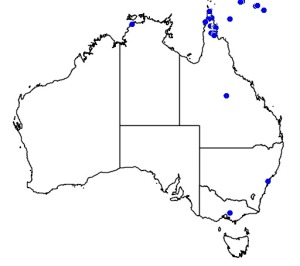Colours
Distinguishing features
It has a round head, small hidden ears, thick fur, and a prehensile tail to aid in climbing. Its eyes range in colour from yellows and oranges to reds, and are slit much like a snake's. All four of its limbs have five digits and strong, curved claws, except the first digit on each foot. The second and third digits of the hind foot are partly syndactylous: they are united by skin at the top joint but divide at the claws. These smaller claws can serve as hair combs when cleaning. The first and second digits of the forefoot are opposable to the other three, helping it grip branches while climbing. The undersides of its paws are bare and striated, which also help it grasp trees and food. The first digit on the hind foot is clawless and opposable.
It has thick, woolly fur of varying colours depending on age, sex, and location. Males are typically grey/white or brown/white with splotchy patterns on their back and a white underbelly. Only males have spots. Females are usually white or grey and unspotted. Some completely white individuals are known in both males and females. As the young grow they go through a series of color changes before reaching sexual maturity at around one year old. Colouration varies from reds, whites, buffs, browns, light greys, and blacks. Unlike some other species of cuscuses or possums, the common spotted cuscus does not have a dorsal stripe on its fur.
The curled, prehensile tail is a distinctive characteristic of the common spotted cuscus. The upper part of the tail closest to the body is covered in fur, while the lower half is covered in rough scales on the inside surface to grip branches. ������(Wikipedia)
Size
- Up to 65 cm (Body length)
- Up to 60 cm (Tail length)
Synonyms
Distribution
Distribution and habitat preferences
It can be found at the top of Cape York Peninsula in Queensland. While uncommon in Australia, it is abundant in Papua New Guinea.
It lives in rainforests, mangroves, hardwood and eucalypt forests below 1,200 metres. (Wikipedia)
Diet
It has an unspecialised dentition, allowing it to eat a wide variety of plant products.
It eats the leaves of ficus, alstonia, slonea plants,nectar, as well as the fruits of ficus, lithocarpus, aglia, and possibly mischocarpus and pometia plants. It is also known to eat flowers, small animals, and occasionally eggs. (Wikipedia)



